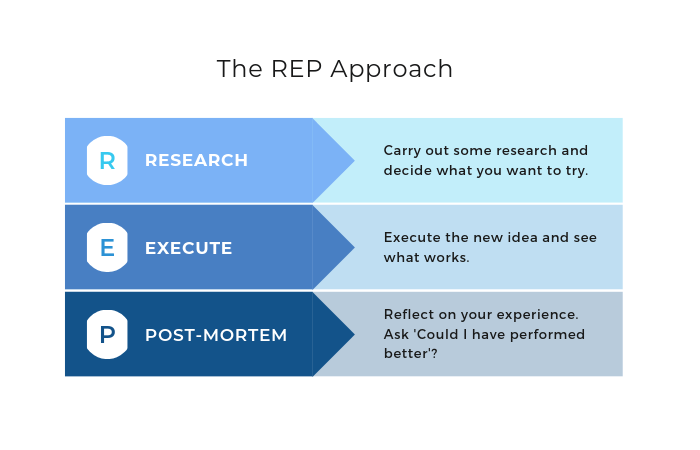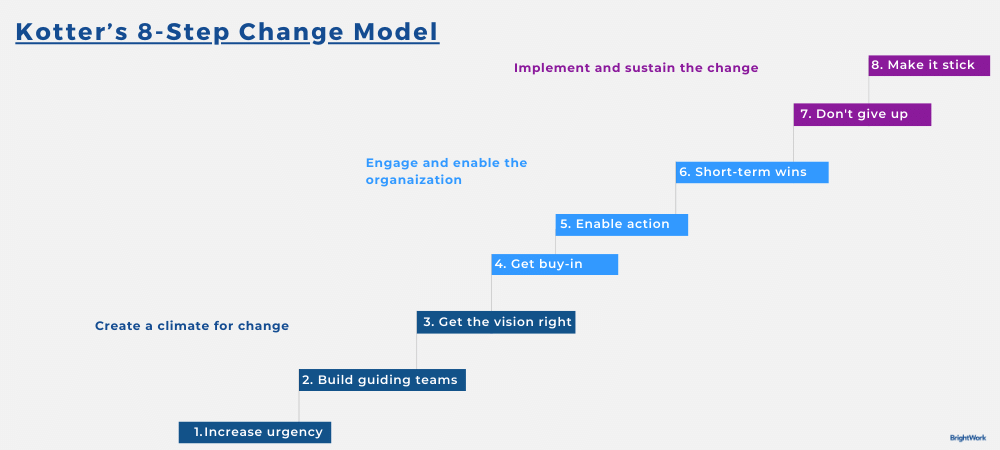What is the Connection Between Change Management and Project Success?
Change management and project management go hand-in-hand. As a project manager, you are responsible for delivering something new, strategic, exciting, challenging, or complex to change an organization’s current status.
Resistance to Change
People often resist change for many reasons. They prefer the status quo, fear losing their job, or worry about being unable to learn something new.
Managing change has become even trickier as organizations and teams deal with the uncertainty and instability created by global events, such as the pandemic.
Short-Term and Long-Term Strategies
We’ll explore change management and project management from two perspectives: short-term and long-term.
Focusing on short-term strategies helps organizations to implement changes quickly while ensuring employees are comfortable with those changes.
This approach should be balanced with a long-term, broader view that prepares organizations for future, rapid changes.
Strategies for Short-Term Change Management
If we’ve learned anything over the past few years, rapid change is here to stay.
Stay-at-home directives, travel restrictions, returning to the office for short periods, and business closures have all become part of our reality.
Dealing with these changes and many other disruptions requires a quick, focused response.
Adapting Quickly in Times of Crisis
The first step is recognizing how quickly individuals and teams can adapt during a crisis. An urgent need for change has created new ways of working while removing the layers of bureaucracy that typically slow teams down.
Introducing the Prosci ADKAR Model
In this section, we’ll take a look at the Prosci ADKAR Model, which refers to:
Awareness of the need for change
Recognizing the driving forces behind the necessary change is vital. It involves effectively communicating the reasons for change to ensure team understanding and buy-in.
Desire to participate and support the change
A positive attitude towards change is essential. It’s about motivating and engaging team members to participate proactively in the change management process.
Knowledge on how to change
Providing the information and training needed to make the change successful. It includes step-by-step guidance and resources to navigate new processes or tools.
Ability to implement required skills and behaviors
Ensuring team members can adopt new skills and behaviors. It might involve hands-on training, mentoring, or coaching to facilitate the transition.
Reinforcement to sustain the change
Maintaining momentum after the change has been implemented is vital. It includes ongoing support, recognizing achievements, and embedding new practices into the organizational culture.
ADKAR focuses on action and how individuals respond to change. The model is based on the best information available to determine the best step to take next.
Implementing ADKAR
Working through this model takes around 30 minutes and generates practical actions to help your team. These free quick-start guides for remote working and returning to the office will put you on the right track.
Prioritizing Additional Areas for Effective Change Management
While the ADKAR model provides a solid framework, several other factors contribute to the success of any change management initiative.
These areas help ensure that changes are implemented, embraced, and sustained over time.
Purpose
Every project should start with a clear goal, typically defined in the project charter. Similarly, every organization should operate with a clear vision in mind.
It’s vital to regularly revisit and reinforce these objectives with your team to help them understand how their efforts contribute to the organization’s larger goals.
When team members find meaning and direction in their work, their engagement and productivity increase, minimizing time spent on tasks that don’t align with the core objectives.
Communication
For remote project teams, clear and consistent communication becomes even more critical. Understanding different communication styles can significantly impact the success of the project.
It’s essential to document everything of significance, such as new processes or decisions, and share this documentation on a collaborative platform accessible to all team members.
For teams across various time zones, utilizing video content for updates and training can be highly effective. Tools within Microsoft 365, like MS Teams and Stream, provide secure options for video communication and improve collaboration and efficiency in your remote workforce.
Feedback
Traditional methods of collecting stakeholder feedback may need to be revised in a remote working environment. It’s necessary to find straightforward and quick ways for individuals to provide input and express their concerns.
Tools like Microsoft Forms or polling apps in Microsoft Teams can facilitate this process, ensuring that the impact of change on individuals is understood and addressed.
Incremental Changes
Deliver small changes quickly to help people adapt and build confidence. As teams work remotely, challenges like running video meetings or collaborating across time zones will arise. Rather than fixing everything at once, pick one issue to work on.
At BrightWork, we use REP for change management:
- Research the problem or opportunity to figure out what you need to do.
- Execute the suggested approaches for a defined period.
- Afterward, perform a post-mortem evaluation on these approaches to identify what did not work.

REPs may be delivered over a week, month, or year – depending on the situation! Organizations need to manage short-term changes while preparing for long-term opportunities and future disruptions.
What is the Difference Between Project Management and Change Management?
It’s important to understand how project management and change management differ while recognizing how they complement each other. While they overlap, each has its unique focus and purpose in driving organizational success.
Project Management
Project Management involves planning, initiation, execution, monitoring, and closure of tasks using technical skills and strategic management. It focuses on a structured approach to turning ideas into reality within a project timeline.
It’s about managing the entire project lifecycle to meet project objectives.
Defined Duration and Scope
Projects are temporary, with specific start and end dates, designed to deliver unique outcomes. Their limited duration requires a focused and efficient approach to achieve the desired results within the project baselines and schedules.
Delivering Unique Value
Each project creates distinct deliverables that align with an organization’s strategic goals. Project management teams must adeptly manage constraints like scope, time, and budget to deliver these successful project outcomes.
Leadership and Adaptation
Effective project leadership involves changing teams and ensuring strategic alignment with the business’s evolving needs. Balancing technical precision with team dynamics is key to a successful project.
Change Management
Change management is a structured approach to handling organizational changes resulting from projects or external factors. It focuses on managing the people, processes, and tools that influence project scope and outcomes.
Change management is the bridge that moves people from their current state to a desired future state without rigid structures or fixed timelines. Instead, it emphasizes flexibility and human-centered transitions.
Goals and Integration with Project Management
The ultimate goal of change management is to enable organizations to realize their strategic vision efficiently. It is not a standalone process – instead, it should be integrated into the overall project management process.
This integration ensures that both project and change managers work in tandem to achieve a positive outcome for all stakeholders involved in the project, including project sponsors.
Roles and Responsibilities
The change manager is pivotal in identifying the individuals and teams affected by the changes. They develop a strategic plan to secure buy-in and facilitate introducing new initiatives while considering potential risks and additional costs.
This process involves ensuring stakeholders and leaders support the change and set a positive example for others, contributing to organizational success.
For more in-depth guidance, check out these change management tips to help manage your project management challenges.
Impact of Change Management
Effective change management can be the determining factor in the success or failure of a project. As a project manager, being well-versed in various change management models and the key factors contributing to their success is essential.
Depending on the project’s scope and the resources at your disposal, you may also lead change management efforts, highlighting the importance of this knowledge.
What are Change Management Models?
Change management provides structured approaches for organizations to manage and implement change.
Each model offers a different perspective on approaching the complexities of change, whether incremental or radical. Here’s an overview of the popular change management models:
The Strategic Change model
The Strategic Change Model divides organizational change into four types based on pace and impact. These classifications help organizations understand the scale and urgency of the differences they are facing:
- Evolution – This gradual change involves small steps to improve and evolve the organization without causing significant disruptions.
- Adaption – Incremental adaptation consists of a series of changes implemented over time, allowing the organization to adjust and refine its strategies as it progresses.
- Revolution – When fundamental shifts are necessary, revolution change is invoked. This often involves a comprehensive overhaul of strategy, structures, and cultures to align with new, pressing realities.
- Reconstruction – Reconstruction is about rapid transformation, where multiple changes are implemented simultaneously, necessitating a swift and decisive action plan to reconfigure organizational processes and frameworks.
Kotter’s 8-step process
Kotter’s 8-step process emphasizes the importance of employee buy-in and support for successful change implementation.

The steps are designed to create a smooth transition with a high level of engagement from the workforce:
- Create urgency – Build a sense of urgency around the need for change to motivate the team to move forward.
- Form a powerful coalition – Assemble a group with enough power to lead the change effort and encourage them to work as a team.
- Create a vision for change – Develop a clear vision to help everyone understand why you ask them to take action.
- Communicate the vision – Ensure that as many people as possible understand and accept the vision and the strategy.
- Remove obstacles – Identify and remove barriers to change and empower people to execute the vision.
- Create short-term wins – Plan for and create short-term “wins” that people can see and celebrate, helping to build momentum.
- Build on the change – Analyze what went right and what needs improving, and set goals to continue building on the momentum of change.
- Anchor the changes in organizational culture – Reinforce the changes by highlighting performance and success, ensuring they stick in the long term.
The Change Curve
The Change Curve model anticipates the emotional journey individuals undergo during organizational change.
It is a predictive tool for understanding the natural progression of employee reactions. It is instrumental in managing and supporting people through the transition. The model consists of four stages:
- Stage 1 – People react to the required change with shock or denial, resisting challenges to the status quo.
- Stage 2 – Once the change is accepted as inevitable, individuals may become harmful, angry, disruptive, and even fearful for their future with the organization.
- Stage 3 – Gradually, individuals begin to accept the changes, learning what they mean to them and how they must adapt to change.
- Stage 4 – The difference is embraced as individuals develop new working habits and processes. The organization will benefit from the change.
Lewin’s Change Management Model
Lewin’s Change Management Model characterizes change as ‘Unfreeze, Change, Freeze.’
1. Unfreeze
Firstly, the organization must accept that a change is inevitable and communicate the need for change effectively.
This ‘unfreezes’ individuals, making them open to change. Naturally, this phase can lead to extensive uncertainty and anxiety for individuals and teams.
2. Change
Next, change occurs as individuals seek to resolve uncertainty and look to a new, improved future state. Time and communication are critical to this phase.
3. Refreeze
Finally, ‘refreeze’ becomes possible as changes are accepted within the organization.
Choosing the Right Model
Other approaches include the Switch Framework, William Bridge’s Transition Model, and the Kubler-Ross Change Curve.
Spend time assessing the required change, available resources, and company culture before selecting a model to guide the change process. In this assessment, consider how Brightwork 365 integrations can facilitate the adoption of new tools and techniques across your teams.
Regardless of the chosen approach, these tips will help to make change management successful.
4 Success Factors for Change Management
Effective change management is critical for ensuring that organizational changes are accepted and adopted.
Several success factors can significantly influence the outcome of change initiatives. Here’s an expanded look at four of these critical factors:
1. Identify Impacted Individuals
Before announcing any changes, identify the individuals and teams who will be affected. Spend time with these individuals to understand how the change affects their daily routines.
This will also reveal potential conflicts and points of resistance, which will help you develop effective issue management practices and assess any training materials or additional support needed.
Try tools such as interviews, focus groups, brainstorming sessions, and facilitation to collect this information.
2. Clear Case for Change
It is essential not to fall victim to the ‘curse of false knowledge’ by assuming everyone will understand why the change is being made as much as you and your team do.
Prepare a written statement outlining why the change is being made, the benefits of the change, and the roadmap to your new destination.
Encourage feedback where possible, for example, through workshops or an online tool.
3. Strong Leadership
The case of change begins at the top! Leaders must understand and agree with the change, visibly support the case for change, and repeat the benefits at every opportunity.
Many organizations are now turning to social networks and online communities to identify hidden influencers – people who are respected by their colleagues and, therefore, could play a role in the change program.
Tap into the ‘ripple effect’ by appointing organizational change ambassadors.
4. Communication Strategies
The case for change should be shared regularly, consistently, and across different channels.
Use face-to-face communication such as meetings, individual sessions, online sessions, and workshops where possible. Keep email to a minimum, as this tends to impersonalize the message.
Other communication channels include internal social platforms, training sessions, video messages and voicemails from senior leaders, online polls, case studies, and town hall meetings.
Building Stronger Change Management Strategies
As you gear up for your upcoming projects, increasing user adoption of change management in your project planning is not just beneficial – it’s imperative.
Here’s a streamlined checklist to help guide you:
- Evaluate existing strategies – Review your current change management strategies. Are they up-to-date and capable of handling today’s complexities?
- Collaborate and develop – If you find gaps or outdated practices, collaborate with your project team or engage with key stakeholders to develop responsive and flexible strategies considering project requirements and resource allocation.
- Embed change management – Make change management an integral part of your project planning. This foresight can be the difference between a project that stumbles and soars, steering the project to success.
- Prepare for the human element – Anticipate the human response to change. Plan for it, communicate effectively, and create a project management culture that not only expects change but is empowered by it, thus enhancing project performance.
- Stay agile and informed – Change management is not static. Keep abreast of new trends, tools, and methodologies. Use project management tools to stay in control and adapt to challenges.
- Continuous improvement – Treat each project as an opportunity to refine your change management approach. Post-project reviews can be gold mines for insights and lessons learned, essential for improving project management practice.
Get the Collaborative Project Management Handbook
Improve your leadership, collaboration, and project management skills with “Collaborative Project Management: A Handbook” written by Éamonn McGuinness.

